Developing the right skills and competencies is essential for any sales organization. To make this development consistent over time, companies need a clear structure that defines what good performance looks like and how it can be improved.
That structure is the Sales Competency Model — a framework that translates strategy into specific, measurable capabilities.
A well-designed model aligns recruitment, training, and coaching with company objectives. It provides a shared language between managers, salespeople, and support functions, ensuring that everyone understands which abilities matter most and how they contribute to customer and business results.
By linking individual skills and collective competencies to measurable sales performance, the model ensures that professional growth directly supports both capability development and business outcomes.
The Sales Competency Model is also a cornerstone of sales enablement frameworks — connecting capability development with business strategy and execution. This structured approach to competency development strengthens alignment between talent, training, and go-to-market priorities. Building on the foundation of Sales Competencies, a structured model ensures these capabilities evolve coherently across the organization.
Competency models give structure to sales enablement. They define the critical abilities that support success — not only what salespeople must know, but also what they must be able to do.
When a model is shared across the organization, it clarifies expectations and strengthens fairness in evaluation and development. Moreover, it becomes a foundation for consistent training, skills assessment, and coaching practices across global teams.
Managers can use the model to guide coaching discussions, HR can design learning programs around it, and individuals can assess their own progress. The result is greater transparency, stronger collaboration, and a clear link between personal growth and business outcomes. They also ensure consistency between training, coaching, and sales execution — helping teams maintain alignment as strategies evolve and customer expectations shift.
A sales competency model defines the mix of knowledge, skills, and competencies required to perform effectively in sales roles. It outlines the main dimensions of competence, the expected levels of mastery, and the measurable indicators that show progression over time.
A strong competency model integrates both hard skills — such as market, product, and financial knowledge — and soft skills, including communication, collaboration, and negotiation. Together, these elements provide a complete view of what drives performance in sales roles.
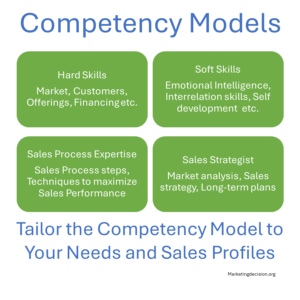
Competency models include detailed descriptions for each role — whether in sales or in functions supporting sales activities. Skills and competencies are described across different proficiency levels, with clearly defined expectations for each position. Because roles and responsibilities vary, customizing the competency model is essential to reflect specific requirements and ensure relevance.
Every company operates within its own market, culture, and offer. For this reason, no two competency models are identical. Each organization must adapt its model to align with its go-to-market strategy, sales enablement system, customer environment, and strategic priorities.
At its core, the model provides a common framework for dialogue — helping everyone involved in sales, from management to front-line teams, identify strengths, address development needs, and plan targeted actions for continuous improvement. As a result, the Sales Competency Model serves as both a management tool and a shared learning reference across the company.
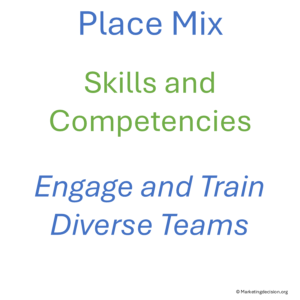 Salespersons are not defined by a single ideal profile. Each individual brings unique traits, experiences, and motivations. Some excel in relationship building, others in analysis, negotiation, or solution design. This diversity should be valued, not flattened.
Salespersons are not defined by a single ideal profile. Each individual brings unique traits, experiences, and motivations. Some excel in relationship building, others in analysis, negotiation, or solution design. This diversity should be valued, not flattened.
Organizations that encourage such diversity create environments where people can use their strengths and receive support where they are less strong. In addition, the best models highlight that every team member can contribute unique value by leveraging their personal mix of skills and competencies.
Sales enablement provides this framework — it builds confidence, encourages learning, and connects people around shared objectives. The most effective models replace the notion of weakness with “needs for development,” reinforcing a positive culture of growth and ownership.
Effective competency models must integrate this human understanding. Regular exchanges, peer coaching, and cross-team mentoring further strengthen collaboration, turning individual progress into collective improvement.
Creating a competency model is a collaborative process involving all key functions: Human Resources, Sales Training, Marketing, and CRM experts.
It should capture the shared perspective of those contributing to sales success.
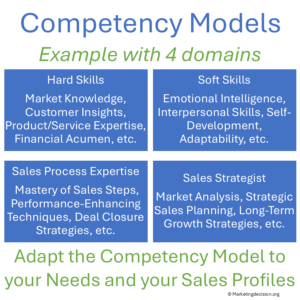 A comprehensive model typically covers several dimensions, each with clear expectations for sales and support roles:
A comprehensive model typically covers several dimensions, each with clear expectations for sales and support roles:
When designing a model, evaluate it against several criteria: completeness, clarity, alignment with training programs, integration with CRM systems, measurable impact, and scalability. Models often start with sales and support functions, then extend to marketing and customer-facing teams that benefit from structured development.
In addition, defining performance metrics early in the design process ensures the competency model connects to measurable business outcomes such as conversion rates, pipeline quality, and sales effectiveness.
Design begins with clarity about business priorities. Identify the abilities that most influence customer outcomes — such as value creation, relationship management, or negotiation. Then describe what good performance looks like at different expertise levels, from new entrants to experienced professionals.
Engage managers and salespeople throughout the process so they take ownership of the model. Once validated, it becomes the foundation for recruitment, training, and performance reviews.
Regular validation keeps the model relevant. A living framework evolves with market conditions, feedback, and technological change — turning strategy into sustained capability. It also ensures that the organization maintains alignment between sales enablement initiatives, performance measurement, and evolving customer expectations. Moreover, linking feedback from CRM and coaching programs helps continuously refine the model based on observed sales performance.
Although each organization defines its own structure, most models converge on four core dimensions that together describe sales excellence.
The ability to read markets, anticipate customer needs, and position solutions early in the buying process. It enables sales teams to focus effort where it truly matters.
The capacity to build trust, listen actively, and tailor communication to each audience. Every interaction should reinforce the relationship and contribute to long-term partnership.
Connecting the company’s offer to customer objectives. It requires clarity in expressing differentiation, linking features to benefits, and justifying price with confidence. This dimension bridges sales, marketing, and pricing for coherent market messaging.
Maintaining a steady, reliable sales rhythm through organization, time management, and follow-up. Short, regular one-to-one reviews and focused team meetings sustain alignment and continuous improvement.
Together, these dimensions provide a balanced view of performance — insight, engagement, persuasion, and execution.
A competency model delivers the most value when integrated into daily management.
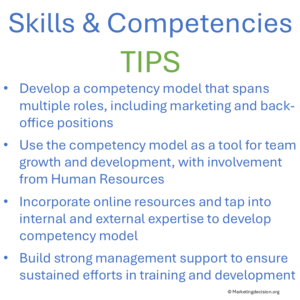
In recruitment, it identifies candidates whose profiles match organizational needs.
In training, it guides program design and prioritization.
In coaching, it provides a shared framework for feedback and growth.
And in performance evaluation, it ensures fairness and transparency.
Managers and employees should treat the competency model as a living reference. Through regular assessments, open feedback discussions, and targeted coaching actions, it becomes a practical management tool for continuous development and motivation.
This process can follow a simple loop:
Assess individual competencies.
Discuss strengths and needs for development openly.
Define targeted training or mentoring actions.
Follow up on progress and adjust plans as needed.
This structured approach connects the competency framework directly to sales enablement programs and on-the-job learning, ensuring continuous capability growth.
When embedded in digital tools — CRM systems or learning platforms — the model links observed performance to measurable competencies. Managers can then direct resources where they have the greatest impact and track improvement over time.
For additional insights on alignment and measurement, see related pages on Sales Benchmark, Skills and Competencies, and Territory Design.
Competency models also support broader quality initiatives. By clarifying roles and expectations, they reduce ambiguity and strengthen coordination across marketing, sales, and support teams. The consistency they create improves both customer experience and internal efficiency.
Real learning also comes from experience. Yet learning from mistakes in the field can be costly — in time, opportunity, and customer trust. Structured competency development anticipates these lessons, helping sales teams succeed before performance is at risk and reinforcing a proactive culture of excellence.
Over time, models must evolve with technology and strategy. Periodic reviews maintain alignment with AI-driven analytics, automation tools, and changing customer expectations. When updated regularly, they become not just descriptive but transformative — a lever for continuous improvement across the organization.
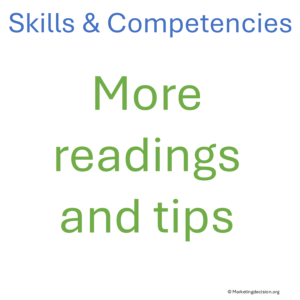 Numerous high-quality resources explore how to design, validate, and apply sales competency models in practice.
Numerous high-quality resources explore how to design, validate, and apply sales competency models in practice.
The following selection provides frameworks and examples that complement the concepts presented in this page:
These articles offer practical examples of how structured models can drive consistency, accelerate learning, and strengthen collaboration across sales and support functions.
Sales competency models transform professional development into a structured, actionable framework. They connect human capability to strategic intent, linking what people learn to what the company achieves. By aligning competencies with customer value creation and measurable sales performance, organizations ensure that learning translates directly into differentiation, growth, and long-term success.
Used effectively, they promote alignment, transparency, and shared purpose — hallmarks of every high-performing sales organization.
In the end, a competency model is more than a management tool. It reflects the company’s ambition and culture — a practical expression of what excellence means and how it can be reached together.
A sales competency model defines the mix of skills, and competencies required for sales success. It helps measure progress and align development with company goals.
They ensure recruitment, training, and evaluation share the same standards. This clarity strengthens alignment between individual performance and business objectives.
Identify the competencies that drive customer outcomes, involve cross-functional teams, define mastery levels, and integrate the model into systems for coaching and tracking.
While models may vary, most include four core dimensions: strategic understanding, customer engagement, value communication, and execution discipline.
Review it every 12–24 months to keep pace with technology, tools, and customer expectations.
© marketingdecision.org
There are numerous tools available on the market for assessing sales competencies. Choose tools that allow fair and constructive discussions between managers and employees, and that facilitate “on-the-job” training for sales staff. For example, nothing is more effective than working on real-life situations with support from a more experienced colleague. Coaching and mentoring are key.
Leverage Scorecards to compare solutions, but only when performance criteria—your “success factors”—are fully agreed upon by the team.
The following section may include tools, some free, some with a fee to support this site development. If you consider a tool should be presented in this section and is missing, please let us know at: contact@marketingdecision.org
© 2025 MARKETING DECISION SOLUTIONS. All Rights Reserved.